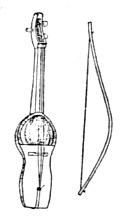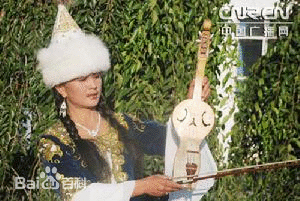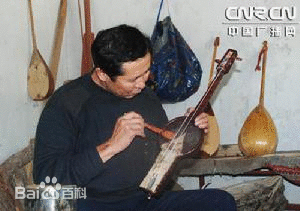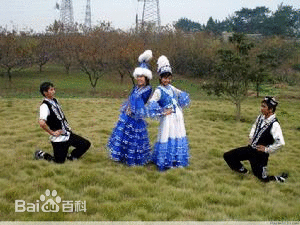Ku Buzi, is Kazakh stringed instrument bow to pull. Chinese language also translated Huo Buzi, Hobbes, Ke Buzi and so on. Long history, structure simple, mellow tone for solo, ensemble or accompaniment. Popular in the Xinjiang Uygur Autonomous Region Ili Kazak Autonomous Prefecture, Balikun, Mori Kazak Autonomous County, Kazak Autonomous Prefecture in Qinghai Haixi Mongolian and Tibetan Aksay Kazak Autonomous County in Gansu Province and other places. Live in the grasslands of the Kazak people, grazing during the day, night guard livestock in the sky studded with stars. And Tamboura, Ku Buzi to play tunes such as smooth, rhythmic, full of intense prairie life breath of music people temporarily forget the hardships and troubles of life.
An Instrument Introduction
Uses and endemic areas
Ku Buzi, is Kazakh stringed instrument bow to pull. Chinese language also translated Huo Buzi, Hobbes, Ke Buzi and so on. Long history, structure simple, mellow tone for solo, ensemble or accompaniment. Popular in the Xinjiang Uygur Autonomous Region Ili Kazak Autonomous Prefecture, Balikun, Mori Kazak Autonomous County, Kazak Autonomous Prefecture in Qinghai Haixi Mongolian and Tibetan Aksay Kazak Autonomous County in Gansu Province and other places.
Legend
According to legend, folk artists: Far In ancient times, Ku Buzi has a close relationship with religion, it is the Kazakh shaman divination and healing to people will use instruments. Wizards in Kazakh occupies a very important position, but he is not a panacea, but by god to dominate everything. Please God shaman in the process, first with Ku Buzi hear tunes playing gods, gods descend only attached to the body of the shaman, and by the shaman’s mouth to answer all kinds of divination. Tools Kubu Zi became a shaman to communicate with the gods, witches playing Ku Buzi higher skills, the more pleasant tunes, the gods appear sooner, a craft Ku Buzi will become a shaman must learn. Every holiday or celebration when Kazak, witches on playing folk music add to the fun, it is also the musical entertainment of the masses. Although the literature history books do not load their produce’s, but the people of the ancient Kazakh and Mongolian, Kirgiz people of good-neighborly neighbors, Ku Buzi and Mongolian stringed instrument care just show Seoul bomb, Kirgiz bowed instrument Keya Ke shape similar origins close view, but also see its long history.
2 Kubu Zi history
The earliest Kubu Zi, also known as Koehler Ku Buzi , is a kind of Kazakh folklore oldest bowed instrument, the piano takes the shape of the bow, with only a ponytail strings, neck and no fingerboard. Due to the production of local materials herders, because material and prepared, often piano style and size specifications are inconsistent. This most primitive pull strings, can still be seen in the current Kazakh remote mountainous areas. Later, on the basis of Koehler Ku Buzi increase pegs (so each one), strings and fretboard, made of two strings Ku Buzi, still use horsetail string or tendon strings, and today it Kirgiz pull stringed Keya Ke very similar.
3 Kubu Zi structure
The traditional Kubu Zi, with a piece of wood piano body dug from the system, a total length of 60 cm – 65 cm (Figure). Spoon-shaped appearance of the resonance box, the next big small, box length 27 cm to 29 cm, the upper half is open exposed, not skin membrane or wooden panels, the lower half of the Mongolian camel lamb or sheep. Headstock no ornaments, under the pillow chord polyphonic groove, with three pegs on both sides (left and right two). Thin and long neck, front no taste. Set have the bridge, three camels tendons chord sheets on film.
4 Kubu Zi storage
Academy of Music in Beijing, China Art Museum, Institute of Chinese musical instruments, display
Ku Buzi
Ku Buzi
With a 库布孜 from Kazakh folk. Piano body with a piece of mulberry wood, length 63 cm, in the lower part of its timber dug up the abdominal cavity, the resonance box semicircular upper and lower semi-cylindrical, piano box length 28.5 cm, width 15 cm on the lower width 10 cm, 8 cm thick, thick 5.5 cm lower, middle and lower part of the Mongolian sheepskin for face, upper dew empty. Headstock was semi-circular curved, rectangular opening chord middle slot, opposite sides of the three-axis (left and right two). Pear wooden pegs for violin chord button type, shaft 6 cm long. Qin wooden horse leather set, Zhang three stringed. Wooden rod bow bow, bow tied with horsetail hair, similar to a violin bow. When in 1959, the music institute famous ethnomusicologist Jane went to Xinjiang its wah survey trips, this piano bought back by the northern. Have been included in “Chinese musical illustrations” in large pictures.
5 Kubu Zi playing
Use when playing posture, legs flat, knees clamped by the lower part of the piano box; Left-handed piano, with the index finger, middle finger, outside of the first joint of the finger to the ring finger, arrived strings from the inside out by the sound, more difficult than large; sticky rosin the bow right hand ponytail outside pull the strings played. Tune a stringed instrument for g, a, d1, range g-g2, there are two octaves. Sound soft and beautiful. Can be used solo, instrumental ensemble or folk songs, dance accompaniment.
6 reform Ku Buzi
Reform Ku Buzi, is pulling Kazakh stringed bow instrument. Popular in the Xinjiang Uygur Autonomous Region Ili Kazak Autonomous Prefecture. ?
Since the 1960s, Xinjiang Ili Kazak Autonomous Prefecture Backstage musician Ali Buick continuous reform Kubu Zi, half of the piano box to Mongolian pine panels, the lower half of the Mongolian sheepskin with python or increase the fretboard, strings increased to four, the use of stringed or steel strings, and made the treble, alto, bass and double bass series Ku Buzi. Tune a stringed instrument with various violin were the same. Treble Ku Buzi, length 60 cm, 24 cm long piano box, the width 15 cm, width 10 cm lower, tuning up for g, d1, a1, e2, range g-e3; Alto Kubu Zi tune a stringed instrument is c, g, d1, a1, range c-c3. ?
When playing the piano box sandwiched between the lower knees, bowing same methods and cello. Treble, alto Ku Buzi is frequently used as a folk singing solo or accompaniment, played by multi Zilazichang. Playing music and more people tune song, better known as “Altay”, “black cursory” and so on. Such reforms Ku Buzi, is full of local characteristics of pulling strings, has been used in the Kazakh national bands.
7 Kubu Zi Collection
Beijing China Art Research Institute, Chinese Academy of Music Instrument Museum has a tenor Ku Buzi. Qin made walnut body, length 75 cm. Piano box back with six pieces of wood glued together to fight, the lower half of a face mask with sheepskin, the upper half of Mongolia to scale loose sheets, piano box length 34 cm, a width of 19.5 cm, width 10 cm lower on thick 7.5 cm, 5 cm under the thick, engraved with two symmetrical music emblem (Western bombs stringed lira) and peach pattern on the panel, along the lines of drilled holes for image tone windows. Headstock like a violin head, top spiral, the next open string slot, located on both sides of the three-axis (left and right two). Pear wooden pegs, strings mention button-shaped shaft length 7 cm, bottom chord groove has strings pillow. Neck semicircular columnar body, before the flat after the round, the front of Anxian fretboard. Leather upper set of wooden piano horses, horse 2 cm long, 3 cm high horse, tied with wooden bottom chord, its always the same shape and violin strings, piano hinge on the bottom end of the next column. Zhang three stringed. Bows for wooden bow rods, sheets horsetail hair bow, bow length 74 cm, set metal spiral tail bow, bow hair Zhang adjustable. This piano made in 1964, the choice of materials and meticulous, sophisticated technology, the panel four weeks bone ornaments inlaid black and white and yellow metal edge Jomon, whole body painted with orange paint, wood clear, beautiful appearance. Has been loaded large album “Chinese musical illustrations” in the.
8 Kazak Ku Buzi
May 18, 2010, the Chinese Ministry of Culture announced the third batch of national intangible cultural heritage list of recommended projects (new selected projects). Ili Kazak Autonomous Prefecture of Xinjiang Uygur Autonomous Region declared “Kazakh Kubu Zi” was selected, the inclusion of non-material cultural heritage of traditional music project category.
9 of Artistic
Ku Buzi, many Kazakh one of the oldest musical instruments, is a stringed musical bow to pull its piano is made of wood, from the piano box, pegs and bow three parts. Full-length piano 60-70 cm wide and 15 cm on the speakers, a wide 10 cm, length 24 cm. Speaker ventral opened lower on the back of Mongolian camel lamb or sheep. On two or three sheets with ponytail or tendon, tendons made of camel strings, strings and bow glue wipe with pine trees. Piano bar and fitted straight fretboard, bending the upper end of the inside of the piano, the piano-shaped belly was Tbsp. Its shape is different from the use of any instrument of a nation in the world, like the sky fly the white swan. Kubu Zi mainly Koehler Ku Buzi, sanxian Ku Buzi, four strings Ku Buzi, yet Ku Buzi and so on. Among them, Koehler Ku Buzi is an ancient musical instrument Kazakh people first invented and used. Arcuate piano lanes, with only a ponytail strings, neck and no fingerboard. Due to the production of local materials herders, because material and prepared, often piano style and size specifications are inconsistent. This most primitive pull strings, can still be seen in the current Kazakh remote mountainous areas.
Uzbek girl Kula Xi Nour too, was in Green River County made a five-year dancer, in a chance where she heard the Ku Buzi playing a song, he was immediately fascinated by this beautiful voice, when she I heard “Ku Buzi” because playing those scarce, and will be faced with extinction, she began a kind of idea to save the national culture, but to give up their favorite dancing career, to get involved in a completely unfamiliar area, is difficult, Some people say, learn Ku Buzi playing is a hard thing, even from the eight-year-old began to learn, after eight years of effort to practice may not be able to grasp all of its skills. Folk had said eight-year-old talents, 40-year-old is not necessarily able to pitch prospective Ku Buzi. Note the Kazakh traditional music, the Ku Buzi playing is the most difficult.
2003, Kula Xi Nour too began to play Kuitun specializing Ku Buzi, due Ku Buzi playing guitar and Tamboura different from using posture while playing, legs flat, knees clamped by the lower part of the piano box; left-handed piano, with the index finger, middle finger, ring finger fingertip to the first lateral joints, arrived strings from the inside out by the sound, more difficult; right hand sticky rosin on the bow string ponytail outside pull-outs.
Ku Buzi piano and violin sound similar to the method than playing the violin complex. To the left hand plucked right hand bow, left and right to get tink seamless fit, which is not easy, especially in the left hand plucked the nail completely on the back hard, just beginning to learn, Kula Xi nails worn every day, bleeding, pain tears every day, a class exercise down, she often burst into tears. Almost half of the time, so she practiced with, pain with tears with, have had to give up Ku Buzi learning and playing, however, inherit and develop traditional culture responsibility for her firm determination and confidence . Three years of study will soon be over, Kula Xi has been able to be flexible Ku Buzi the play, also received a lot of honors, and now she is the most popular music of Green River hand, due to the soft and beautiful tone Ku Buzi . Can be used solo, instrumental ensemble or folk songs, dance accompaniment. She often deeply pastoral play for Kazakh and get artistic inspiration, it is also the truth that she was intoxicated playing.
Since the Altay region very few people would play Ku Buzi, Kula Xi know is that she’s Ana Er and regional art troupe playing. Indeed, in modern popular music and developed today, few people would play Ku Buzi, so playing skills improve Ku Buzi up very slowly, and Kula Xi hopes and experts often discuss techniques, she heard the Kazakh Stan has a lot of playing Kubu Zi artist, her desire to have the opportunity to go out to learn in order to improve their performance on the Ku Buzi and grasp. But this opportunity is hard to get, she only while learning while pondering, it has been able to send their children to start asking her to play here to learn Kubu Zi, which makes her surprise, after all, someone has realized Kubu Zi’s importantly, began to care about the inheritance and development of national culture.
Kazakh nation is not only good at playing music, but also like handmade musical instruments, many producers have their own unique national products. Many of handmade products, fine workmanship, superb. They can hard texture of the roots, trunk dig, carving out Tamboura, Ku Buzi, Sri Lanka and other musical instruments not Swag.
10 production process
Aged 50, according to Rasi Gal sand wood Ahmat is making a master Ku Buzi ‘s. Since childhood, he was full of musical talent, able to follow the radio to listen to music, then you can smoothly play out the melody in his 15-year-old when he made the first to Tamboura, when it sold 15 yuan, from the right making passionate musical instruments out of control, in 1990 he participated in the inaugural Ku Buzi Yili, Dongbula training, from the more traditional national love of music and musical instruments of production, now 28 kinds of Kazakh traditional musical instrument made him well versed last year he produced music for the Xinjiang Institute of Ethnology museum 28 Kazakh traditional instruments, especially Ku Buzi making more with ingenuity, he used a small camel leather made out of Ku Buzi sound good, resilient, with Green River native birch the Ku Buzi produce smooth and delicate piano no cracks, can long-term preservation. According to Rasi Gal sand wood Ahmat If the material is complete, a Ku Buzi need only five days of the time he will be able to complete. According to Rasi Gal sand wood and Kula Xi Ahmat Nour also facing the same problem too, traditional music inherit Houjifaren problem, after all, the power of the two of them are too small. In order to make better Kazakh musical heritage, according to Rasi Gard sand wood Ahmat also been trying to find his successor, continue to instill the idea of making folk instruments, he said: “Never let these instruments in the hands of the lost, we must take them handed down. ”
Real traditional folk music of each song contains a complete story or moral, has its own unique melody. Because many ethnic minorities living in distant places occlusion unknown, but their music has crossed boundaries, penetrating the air, connecting with nature but also with phase, people feel the music is so real and natural, and indeed, the real music, folk, traditional, but also of the world, is not present boundaries. Traditional Kubu Zi’s life should be long, because it play the music, like the scenery for the eyes, it should be an eternal landscape.




